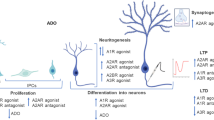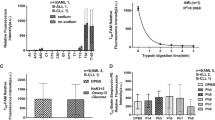Abstract
The transports of nucleosides from blood into neurons and astrocytes are essential prerequisites to enter their metabolic utilization in brain. Adult brain does not possess the de novo nucleotide synthesis, and maintains its nucleotide pools by salvaging preformed nucleosides imported from liver. Once nucleosides enter the brain through the blood brain barrier and the nucleoside transporters, they become obligatory precursors for the synthesis of RNA and DNA and a plethora of other important functions. However, an aliquot of nucleotides are transferred into vesicular nucleotide transporters, and then in the extracellular space by exocytosis of the vesicles, where ATP and UTP interact with a vast heterogeneity of purine and pyrimidine receptors. Their signal actions are terminated by the ectonucleotidase cascade system, which degrades ATP and UTP into adenosine and uridine, respectively. The low specificity of the vesicular nucleotide transporters may explain the presence in the extracellular space of GTP and CTP, which are equally degraded to their respective nucleosides by the ectonucleotidases. The main four nucleosides are re-imported either into the same cell, or in adjacent cells, e.g. between two astrocytes, or between a neuron and an astrocyte, to regenerate nucleoside triphosphates. The molecular network of this metabolic cross-talk, involving the ectonucleotidases, the nucleoside transporters, the nucleotide salvage system, the nucleotide transport into the vesicular nucleotide transporters, and the exocytotic release of nucleotides, called by us the “nucleosidome”, serves the nucleoside recycling in the brain, with a considerable spatial–temporal advantage.






Similar content being viewed by others
Abbreviations
- Ado:
-
Adenosine
- Cyd:
-
Cytidine
- CNT:
-
Concentrative nucleoside transporter
- ENT:
-
Equilibrative nucleoside transporter
- Guo:
-
Guanosine
- HPRT:
-
Hypoxanthine–guanine phosphoribosyltransferase
- Ino:
-
Inosine
- NDP:
-
Nucleoside diphosphate
- NMP:
-
Nucleoside monophosphate
- NTP:
-
Nucleoside triphosphate
- NS:
-
Nucleoside
- SV:
-
Synaptic vesicle
- Urd:
-
Uridine
- VNuT:
-
Vesicular nucleotide transporter
- V-ATPase:
-
Vesicular ATPase
References
Abbracchio, M. P., Burnstock, G., Verkhratsky, A., & Zimmermann, H. (2009). Purinergic signalling in the nervous system: An overview. Trends in Neurosciences, 32, 19–29.
Allsop, J., & Watts, R. W. (1983). Purine de novo synthesis in liver and developing rat brain, and the effect of some inhibitors of purine nucleotide interconversion. Enzyme, 30, 172–180.
Allsop, J., & Watts, R. W. (1984). Purine synthesis and salvage in brain and liver. Advances in Experimental Medicine and Biology, 165, 21–26.
Balasubramanian, S., Duley, J. A., & Christodoulou, J. (2014a). Inborn errors of purine metabolism: Clinical updates and therapies. Journal of Inherited Metabolic Disease, 37, 669–686.
Balasubramanian, S., Duley, J. A., & Christodoulou, J. (2014b). Inborn errors of pyrimidine metabolism: Clinical update and therapies. Journal of Inherited Metabolic Disease, 37, 687–698.
Baldwin, S. A., Beal, P. R., Yao, S. Y. M., King, A. E., Cass, C. E., & Young, J. D. (2004). The equilibrative nucleoside transporter family, SLC29. European Journal of Physiology, 447, 735–743.
Balestri, F., Barsotti, C., Lutzemberger, L., Camici, M., & Ipata, P. L. (2007). Key role of uridine kinase and uridine phosphorylase in the homeostatic regulation of purine and pyrimidine salvage in brain. Neurochemistry International, 51, 517–523.
Bar-Evan, A., Flamholz, A., Noor, E., & Milo, R. (2012). Rethinking glycolysis: On the biochemical logic of metabolic pathways. Nature Chemical Biology, 8, 509–517.
Barsotti, C., & Ipata, P. L. (2004). Metabolic regulation of ATP breakdown and of adenosine production in rat brain extracts. International Journal of Biochemistry & Cell Biology, 36, 2214–2225.
Bourget, P. A., & Trembly, G. C. (1972). Pyrimidine biosynthesis in rat brain. Journal of Neurochemistry, 19(7), 1617–1624.
Burnstock, G. (2004). Cotransmission. Current Opinion in Pharmacology, 4(1), 47–52.
Cansev, M. (2006). Uridine and cytidine in the brain; their transport and utilization. Brain Research Reviews, 52, 389–397.
Cory, J. G. (2006) Purine and pyrimidine nucleotide metabolism. In T. M. Devlin (Ed.), Textbook of biochemistry with clinical correlations. (vol. 6, pp. 789–822). New York: Whiley-Liss.
Gauthier-Kemper, A., Kahms, M., & Klingauf, J. (2015). Restoring synaptic vesicles during compensatory endocytosis. Assays in Biochemistry, 57, 121–134.
Giuliani, P., Ballerini, P., Buccella, S., Ciccarelli, R., Rathbone, M. P., Romano, S., et al. (2015). Guanosine protect glial cells against 6-hydroxydopamine toxicity. Advances in Experimental Medicine and Biology, 837, 23–33.
Giuliani, P., Romano, S., Ballerini, P., Ciccarelli, R., Petragnani, N., Cicchitti, S., et al. (2012). Protective activity of guanosine in an in vitro model of Parkinson’s disease. Panminerva Medica, 54, 43–51.
Gray, J. H., Owen, R. P., & Giacomini, K. M. (2004). The concentrative nucleoside transporter family. European Journal of Physiology, 447, 728–734.
Ipata, P. L. (2013). Brain nucleoside recycle. Metabolomics, 9, 271–279.
Ipata, P. L., Balestri, F., Camici, M., & Tozzi, M. G. (2011a). Molecular mechanisms of nucleoside recycling in the btrain. International Journal of Biochemistry & Cell Biology, 43, 140–145.
Ipata, P. L., Barsotti, C., Tozzi, M. G., Camici, M., & Balestri, F. (2010). Metabolic interplay between intra- and extra-cellular uridine metabolism via an ATP driver uridine-UTP cycle in brain. International Journal of Biochemistry & Cell Biology, 42, 932–937.
Ipata, P. L., Camici, M., Micheli, V., & Tozzi, M. G. (2011b). Metabolic network of nucleosides in the brain. Current Topics in Medicinal Chemistry, 11, 909–922.
Ipata, P. L., & Pesi, R. (2015). What is the true nitrogenase reaction? A guided approach. Biochemistry and Molecular Biology Education, 43, 122–124.
Johnson, R. G. (1988). Accumulation of biological amines into chromaffin granules. A model for hormone and neurotransmitter transport. Physiological Reviews, 68, 232–507.
Jolivet, R., Magistretti, P. J., & Weber, B. (2009). Deciphering neuron-glia compartimentalization in cortical energy metabolism. Front Neuroenergetic, 1, 1–10.
Jureka, A. (2009). Inborn errors of purine and pyrimidine metabolism. Journal of Inherited Metabolic Disease, 32, 247–263.
Kahkh, B. S. (2001). Molecular physiology of P2X receptors and ATP signaling at synapses. Nature Reviews Neuroscience, 2, 165–174.
Kovacs, Z., Dobolyi, A., Juhasz, G., & Kekesi, K. A. (2010). Nucleoside map of the human central nervous system. Neurochemical Research, 35, 452–464.
Kovács, Z., Juhasz, G., Palkovits, M., Dobolyi, A., & Kekesi, K. A. (2011). Area, age and gender dependence of the nucleoside system in the brain: A review of current literature. Current Topics in Medicinal Chemistry, 11, 1012–1033.
Lazarowski, E. R., & Bucher, R. C. (2001). UTP as an extracellular signaling molecule. News in Physiological Sciences, 16, 1–5.
Lecca, D., & Ceruti, S. (2008). Uracil nucleotides: From metabolic intermediates to neuroprotection and inflammation. Biochemical Pharmacology, 75, 1869–1881.
Menendez-Mendez, A., Diaz-Hernandez, J. I., & Miras-Portugal, M. T. (2015). The vesicular nucleotide transporter (VNut) is involved in the extracellular ATP effect on neuronal differentiation. Purinergic Signaling, 11, 239–249.
Micheli, V., Camici, M., Tozzi, M. G., Ipata, P. L., Sestini, S., Bertelli, M., & Pompucci, G. (2011). Neurological disorders of purine and pyrimidine metabolism. Current Topics in Medicinal Chemistry, 11, 923–947.
Norenberg, W., & Illes, P. (2000). Neuronal P2X receptors: Localization and functional properties. Naunyin Schmiedebergs Archives of Pharmacology, 362, 324–339.
Nyhan, W. L. (2005). Disorders of purine and pyrimidine metabolism. Molecular Genetics and Metabolism, 86, 25–33.
Pankratov, Y., Lalo, U., Verkhratsky, A., & North, R. A. (2006). Vesicular release of ATP at central synapses. Pflügers Archiv, 452, 589–597.
Pankratov, Y., Lalo, U., Verkhratsky, A., & North, R. A. (2007). Quantal release of ATP in mouse cortex. Journal of General Physiology, 129, 257–265.
Parkinson, F. E., Damaraju, V. L., Graham, K., Yao, S. Y., Baldwin, S. A., Cass, C. E., & Young, J. D. (2011). Molecular biology of nucleoside transporters and their distributions and functions in the brain. Current Topics in Medicinal Chemistry, 11, 948–972.
Rathbone, M. P., Middlemiss, P. J., Gysbers, J. W., Andrew, C., Herman, M. A., Reed, J. K., et al. (1999). Trophic effects of purines in neurons and glial cells. Progress in Neurobiology, 59, 663–690.
Reimer, P. J., & Edwards, R. H. (2004). Organic anion transport is the primary function of the SLC17/type 1 phosphate transporte family. Pflügers Archiv, 447, 629–635.
Robergs, R. A., Ghiasvand, F., & Parker, D. (2004). Biochemistry of exercise induced metabolic acidosis. American Journal of Physiology: Regulatory, Integrative and Comparative Physiology, 287, R502–R516.
Sawada, K., Echigo, N., Juge, N., Miyaji, T., Otsuga, M., Omote, H., et al. (2008). Identification of a vesicular nucleotide transporter. Proceedings of the National Academy of Sciences, 105, 5683–5686.
Schuldiner, S., Shirvan, A., & Linian, M. (1995). Vesicular neurotransmitter transporters: From bacteria to humans. Physiological Reviews, 75, 369–392.
Volonté, C., & D’Ambrosi, N. (2008). Membrane compartments and purinergic signaling: The purinome, a complex interplay among ligands, degrading enzymes, receptors and transporters. FEBS Journal, 276, 318–329.
Wurtman, R. J. (2008). Synapse formation and cognitive brain development: effect of docosahexaenoic acid and other dietary constituents. Metabolism, 57(Suppl 2), S6–S10. doi:10.1016/j.metabol.2008.07.007.
Wurtman, R. J., Cansev, M., Sakamoto, T., & Ulus, I. H. (2009). Use of phosphatide precursors to promote synaptogenesis. Annual Review of Nutrition, 29, 59–87.
Zimmermann, H. (1992). 5′-Nucleotidase: Molecular structure and functional aspects. Biochemical Journal, 285, 345–365.
Zimmermann, H. (1996). Biochemistry, localization and functional roles of ecto-nucleotidases in the nervous system. Progress in Neurobiology, 49, 589–618.
Zimmermann, H. (2006). Ecto-nucleotidases in the nervous system. In Novartis foundation symposium 276 purinergic signalling in neuron-glial interaction (pp. 113–128). New york: Wiley.
Zimmermann, H. (2008). ATP acetylcholine equal brethren. Neurochemistry International, 52, 634–648.
Acknowledgements
We thank Prof. Giovanni Cercignani for useful discussion on synaptic vesicle structure and function.
Funding
This study was supported by local funds of University of Pisa.
Author information
Authors and Affiliations
Corresponding author
Ethics declarations
Conflict of interest
Author Piero Luigi Ipata declares that he has no conflict of interest. Author Rossana Pesi declares that she has no conflict of interest.
Ethical approval
All applicable international, national, and/or institutional guidelines for the care and use of animals were followed. This article does not contain any studies with human participants performed by any of the authors.
Rights and permissions
About this article
Cite this article
Ipata, P.L., Pesi, R. Nucleoside recycling in the brain and the nucleosidome: a complex metabolic and molecular cross-talk between the extracellular nucleotide cascade system and the intracellular nucleoside salvage. Metabolomics 12, 22 (2016). https://doi.org/10.1007/s11306-015-0931-3
Received:
Accepted:
Published:
DOI: https://doi.org/10.1007/s11306-015-0931-3




